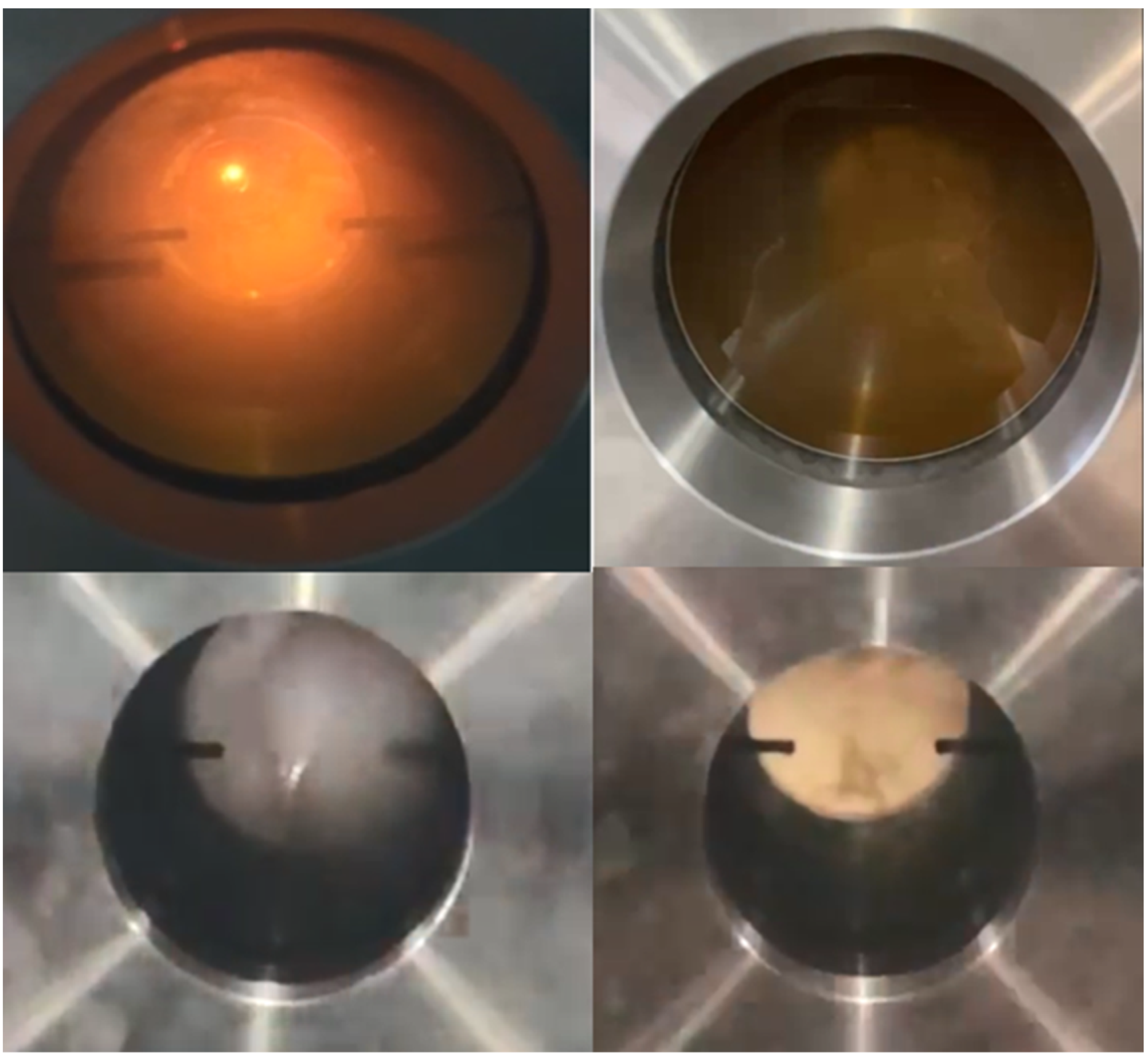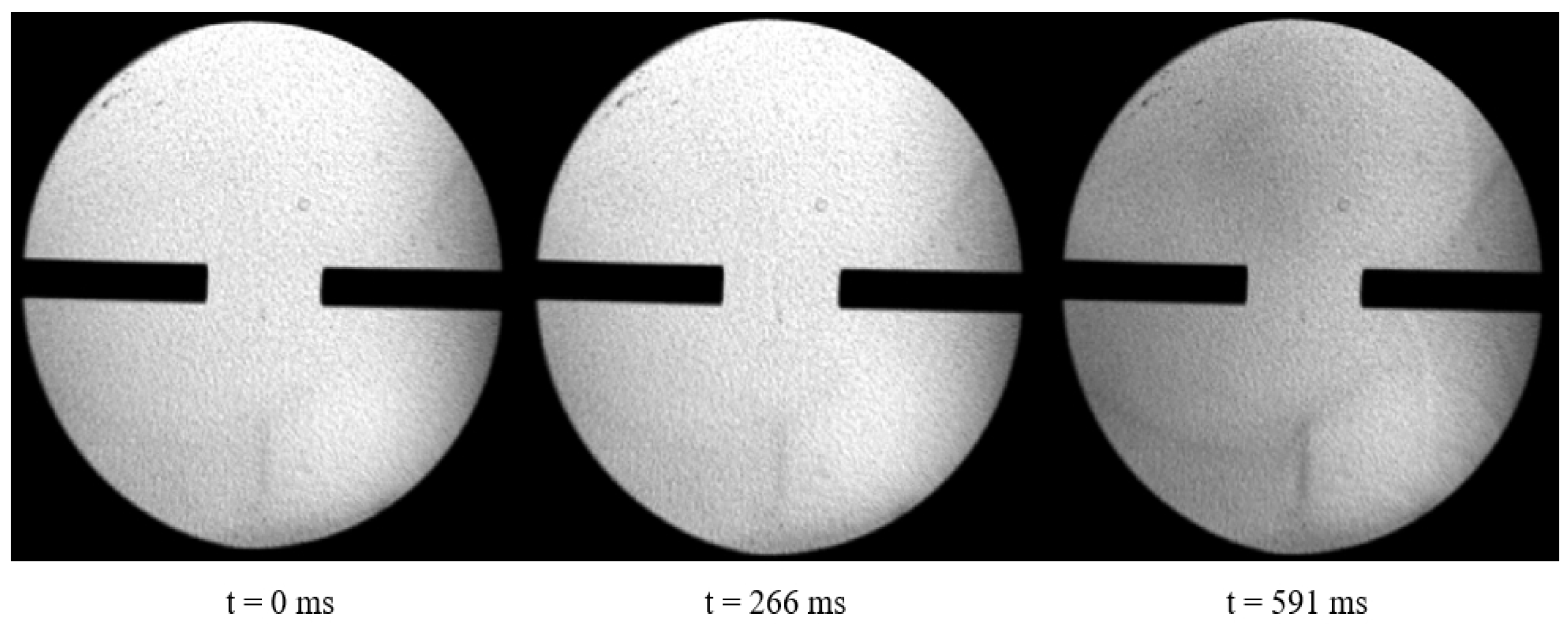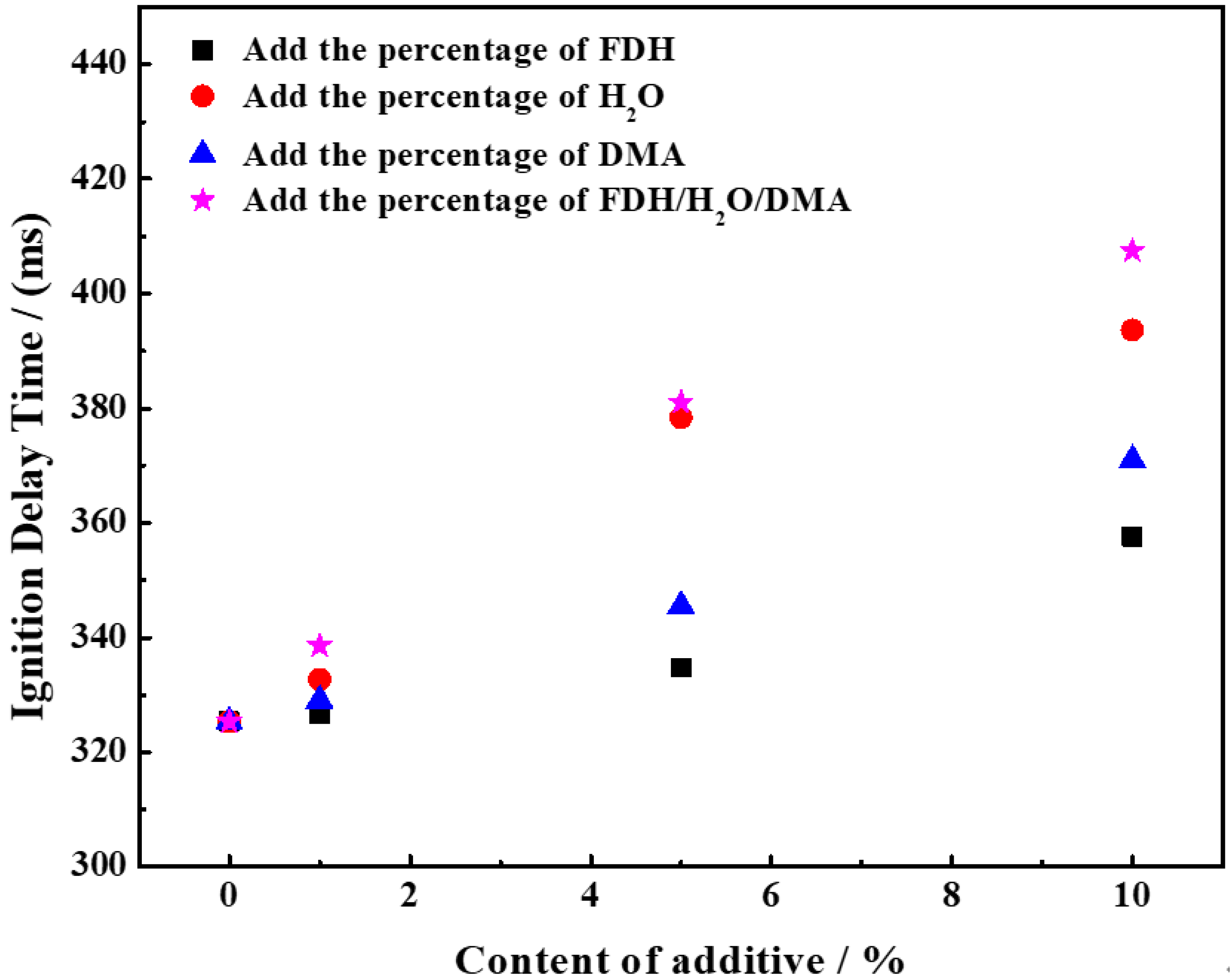Study of Hedge Ignition and Flame Propagation Characteristics of Unsymmetrical Dimethylhydrazine and Its Metamorphosed Mixtures in a Nitrogen Tetroxide Atmosphere
Abstract
:1. Introduction
2. Experimental Section
2.1. Experimental Setup
2.2. Fuels
2.3. Commissioning of Equipment
2.4. Experimental Procedure
2.5. Error Analysis
3. Results and Discussion
3.1. Ignition Delay Time Measurement Results
3.2. Measurement Results of Flame Propagation Characteristics
4. Conclusions
Author Contributions
Funding
Data Availability Statement
Conflicts of Interest
References
- Zhou, F.; Reng, X.H.; Qiang, H.F.; Zeng, Y.Z.; Fan, M.M. GO enhancement of Visible Light Response of g-C3N4 Aerogel and Photocatalytic Degradation of Undimethylhydrazine Wastewater. Mater. Eng. 2021, 49, 171–178. [Google Scholar]
- Hao, Z.W.; Jia, Y.; Yin, L.F.; Su, J.; Wang, H.Y. Study on Degradation of Undimethylhydrazine Wastewater by Electrocatalytic Oxidation. Appl. Chem. Ind. 2022, 51, 1261–1266. [Google Scholar]
- Huang, L.C.; Ye, J.F.; Wang, D.K.; Zheng, Y.Z. Experimental Study on Degradation of Undimethylhydrazine Wastewater by Low Temperature Plasma. Energet. Mater. 2022, 30, 1013–1021. [Google Scholar]
- Guo, Z.; Cheng, Y.X.; Zhang, Z.J. Ozone-micro Nano Bubble Advanced Oxidation Coupling Process for Hydrazine Wastewater Treatment. Ind. Water Treat. 2021, 41, 94–98. [Google Scholar]
- Luo, S.T.; Fu, Y.W.; Zhang, M.Y.; Liu, Y.F.; Wang, D.K.; Zhang, J.W.; Liu, D.X.; Rong, M.Z. Theoretical Study on the Degradation Pathways of Unsymmetrical Dimethylhydrazine by Aqueous. Plasma Chem. Plasma Process. 2023, 43, 81–97. [Google Scholar] [CrossRef]
- Hou, R.M.; Jia, Y.; Huang, Y.Z.; Shen, K.K.; Zhu, H.X. TiO2 reduced graphene oxide for the removal of gas-phase unsymmetrical dimethylhydrazine. New J. Chem. 2021, 45, 394–402. [Google Scholar]
- Koroleva, T.V.; Semenkov, I.N.; Lednev, S.A.; Soldatova, O.S. Unsymmetrical Dimethylhydrazine (UDMH) and Its Transformation Products in Soils: A Review of the Sources, Detection, Behavior, Toxicity, and Remediation of Polluted Territories. Eurasian Soil Sci. 2023, 56, 210–225. [Google Scholar] [CrossRef]
- Angaji, M.T.; Ghiaee, R. Decontamination of unsymmetrical dimethylhydrazine waste water by hydrodynamic cavitation-induced advanced Fenton process. Ultrason. Sonochem. 2015, 23, 257–265. [Google Scholar] [CrossRef]
- Yu, L.W. Study of eu-doped nano-zno Photocatalytic Degradation of Unsymmetrical Dimethyl-Hydrazine. 2009. Available online: https://webofscience.clarivate.cn/wos/alldb/full-record/PQDT:67185869 (accessed on 23 May 2023).
- Liang, M.L.; Li, W.J.; Qi, Q.; Zeng, P.C.; Zhou, Y.C.; Zheng, Y.P.; Wu, M.; Ni, H.M. Catalyst for the degradation of 1,1-dimethylhydrazine and its by-product N-nitrosodimethylamine in propellant wastewater. RSC Adv. 2016, 6, 5677–5687. [Google Scholar] [CrossRef]
- Zhan, X.; Cui, C.Y.; Zhou, X.D.; Xin, T.D.; Han, X.Y. Numerical Simulation of Reaction between Undimethylhydrazine and Nitrogen Dioxide Gas. Missiles Space Veh. 2019, 1, 59–63+79. [Google Scholar]
- Xu, Z.L.; Chen, F.; Huang, L.Z.; Guo, W.Z. Determination of Oxidation Products of Undimethylhydrazine in Storage by Gas Chromatography-Mass Spectrometry. J. Explos. Explos. 2018, 41, 523–530. [Google Scholar]
- Bhosale, V.K.; Karnik, S.; Kulkarni, P.S. Ignition Study of Amine Borane/Cyanoborane Based Green Hypergolic Fuels. Combust. Flame 2019, 210, 1–8. [Google Scholar] [CrossRef]
- He, B.; Nie, W.; Feng, S.; Su, L.; Zhuang, F. Effects of NTO Oxidizer Temperature and Pressure on Hypergolic Ignition Delay and Life Time of UDMH Organic Gel Droplet. Propellants Explos. Pyrotech. 2013, 38, 665–684. [Google Scholar] [CrossRef]
- Feng, S.; He, B.; He, H.; Su, L.; Hou, Z.; Nie, W.; Guo, X. Experimental Studies the Burning Process of Gelled Unsymmetrical Dimethylhydrazine Droplets under Oxidant Convective Conditions. Fuel 2013, 111, 367–373. [Google Scholar] [CrossRef]
- Salvador, C.A.V.; Costa, F.S. Vaporization Lengths of Hydrazine Fuels Burning with NTO. J. Propuls. Power 2006, 22, 1362–1372. [Google Scholar] [CrossRef]
- Swami, U.; Senapathi, K.; Srinivasulu, K.M.; Desingu, J.; Chowdhury, A. Ignition Delays of Mixtures of the Non-Hypergolic Energetic Ionic Liquid Hydroxyethylhydrazinium Nitrate Blended with Unsymmetrical Dimethylhydrazine. Propellants Explos. Pyrotech. 2019, 44, 1139–1146. [Google Scholar] [CrossRef]
- Wang, S.; Thynell, S. An Experimental Study on the Hypergolic Interaction between Monomethylhydrazine and Nitric Acid. Combust. Flame 2012, 159, 438–447. [Google Scholar] [CrossRef]
- Dennis, J.D.; Son, S.F.; Pourpoint, T.L. Critical Ignition Criteria for Monomethylhydrazine and Red Fuming Nitric Acid. J. Propuls. Power 2015, 31, 1184–1192. [Google Scholar] [CrossRef]
- Zhang, D.; He, C.; Zhang, P.; Tang, C. Mass Interminglement and Hypergolic Ignition of TMEDA and WFNA Droplets by Off-Center Collision. Combust. Flame 2018, 197, 276–289. [Google Scholar] [CrossRef]
- Liu, W.-G.; Wang, S.; Dasgupta, S.; Thynell, S.T.; Goddard, W.A.; Zybin, S.; Yetter, R.A. Experimental and Quantum Mechanics Investigations of Early Reactions of Monomethylhydrazine with Mixtures of NO2 and N2O4. Combust. Flame 2013, 160, 970–981. [Google Scholar] [CrossRef]
- Catoire, L.; Chaumeix, N.; Pichon, S.; Paillard, C. Visualizations of Gas-Phase NTO/MMH Reactivity. J. Propuls. Power 2006, 22, 120–126. [Google Scholar] [CrossRef]
- Shi, Y.H.; Hu, Y.P.; Li, M.H.; Guo, L.L. Numerical Simulation of Thermal Dynamic Characteristics of UDMH Pool Fire. Sci. Technol. Eng. 2023, 23, 8464–8471. [Google Scholar]
- Jiang, Y.D.; Xu, Q.Y.; Ma, Y.L.; Cheng, Y. Dynamic Response Study of Hydrazine-Based Monocomponent Rocket Engine. J. Aeronaut. 2023, 1–13. Available online: http://kns.cnki.net/kcms/detail/11.1929.v.20230921.1021.002.html (accessed on 12 November 2023).
- He, B.; Feng, S.J.; Nie, W.S. Numerical Simulation of Chemical Delay Time of Liquid Rocket Hypergolic Propellant. J. Syst. Simul. 2013, 25, 612–615+625. [Google Scholar]
- Huang, Z.Y.; Luo, F.; Shi, H.W.; Wang, X.J. Numerical Simulation of Diffusion of Unsymmetrical Dimeythylhrazine Under Storage Condition. Sci. Technol. Rev. 2011, 29, 67–70. [Google Scholar]
- Wang, F.S.; Yao, Z.P.; Liu, Y.; Zhang, Z.; Cai, K.; Wang, P.; Mao, X.F.; Yang, L. Numerical and Experimental Analysis of Pulse Mode Characteristics in a MMH/NTO Rocket Engine. Aerosp. Control Appl. 2021, 47, 56–62. [Google Scholar]
- Wu, R.; Nie, W.S.; Cai, H.H.; Qiao, Y.; Feng, W. Three-dimensional Simulation Study of UDMH/NTO Rocket Engine Plume Flow Field Characteristics. Missiles Space Veh. 2016, 5, 74–79. [Google Scholar]
- Feng, S.J.; He, B.; Nie, W.S. Progress in combustion characteristic research of liquid rocket gelled propellants. J. Rocket Propuls. 2009, 35, 1–7+13. [Google Scholar]
- Fu, Q.; Du, Z.; Lan, H.; Yu, S.; Yang, C. Preparation and properties research of UDMH/NTO gel propellant. J. Rocket Propuls. 2006, 32, 48–53. [Google Scholar]
- Han, W.; Du, Z.G.; Fu, Q.J.; Lan, H.P.; Yang, C.; Wu, J.; Yu, J. Study on the formulation of NTO gelled propellant. J. Rocket Propuls. 2008, 34, 54–58. [Google Scholar]













| Author | Article Title | Research Methods |
|---|---|---|
| Shi Y, Hu Y, Li M, et al. [23]. | Numerical Simulation of Thermal Dynamic Characteristics of UDMH Pool Fire | Numerical Simulation |
| Jiang Y, Xu Q, Ma Y, et al. [24]. | Dynamic Response Study of Hydrazine-based Monocomponent Rocket Engine | Numerical Simulation |
| He B, Feng S, Nie W [25]. | Numerical Simulation of Chemical Delay Time of Liquid Rocket Hypergolic Propellant | Numerical Simulation |
| Huang Z, Luo F, Shi H, et al. [26]. | Numerical Simulation of Diffusion of Unsymmetrical Dimeythylhrazine Under Storage Condition | Numerical Simulation |
| Wang F, Yao Z, Liu Y, et al. [27]. | Numerical and Experimental Analysis of Pulse Mode Characteristics in a MMH/NTO Rocket Engine | Numerical Simulation |
| Wu R, Nie W, Cai H, et al. [28]. | Three-dimensional Simulation Study of UDMH/NTO Rocket Engine Plume Flow Field Characteristics | Numerical Simulation |
| Feng S, He B, Nie W [29]. | Progress in combustion characteristic research of liquid rocket gelled propellants | Literature review |
| Q.J. Fu, Z.G. Du, H.P. Lan, et al. [30]. | Preparation and properties research of UDMH/NTO gel propellant | experiment |
| W. Han, Z.G. Du, Q.J. Fu, et al. [31]. | Study on the formulation of NTO gelled propellant | experiment |
| Molar Concentration of the Mixture/% | P | T | |||||
|---|---|---|---|---|---|---|---|
| UDMH | DMA | FDH | H2O | DMA/FDH/H2O | NTO | Pa | K |
| 9.00 KPa | 70 KPa | 400 | 293 | ||||
| 8.91 KPa | 90 Pa (1%) | 70 KPa | 400 | 293 | |||
| 8.55 KPa | 450 Pa (5%) | 70 KPa | 400 | 293 | |||
| 8.10 KPa | 900 Pa (10%) | 70 KPa | 400 | 293 | |||
| 8.91 KPa | 90 Pa (1%) | 70 KPa | 400 | 293 | |||
| 8.55 KPa | 450 Pa (5%) | 70 KPa | 400 | 293 | |||
| 8.10 KPa | 900 Pa (10%) | 70 KPa | 400 | 293 | |||
| 8.91 KPa | 90 Pa (1%) | 70 KPa | 400 | 293 | |||
| 8.55 KPa | 450 Pa (5%) | 70 KPa | 400 | 293 | |||
| 8.10 KPa | 900 Pa (10%) | 70 KPa | 400 | 293 | |||
| 8.73 KPa | 270 Pa (3%) | 70 KPa | 400 | 293 | |||
| 7.65 KPa | 1350 Pa (15%) | 70 KPa | 400 | 293 | |||
| 6.30 KPa | 2700 Pa (30%) | 70 KPa | 400 | 293 | |||
Disclaimer/Publisher’s Note: The statements, opinions and data contained in all publications are solely those of the individual author(s) and contributor(s) and not of MDPI and/or the editor(s). MDPI and/or the editor(s) disclaim responsibility for any injury to people or property resulting from any ideas, methods, instructions or products referred to in the content. |
© 2023 by the authors. Licensee MDPI, Basel, Switzerland. This article is an open access article distributed under the terms and conditions of the Creative Commons Attribution (CC BY) license (https://creativecommons.org/licenses/by/4.0/).
Share and Cite
Wang, X.; Feng, Y.; Zhang, J.; Ma, R.; Wu, J.; He, R.; Li, Y.; Liang, J. Study of Hedge Ignition and Flame Propagation Characteristics of Unsymmetrical Dimethylhydrazine and Its Metamorphosed Mixtures in a Nitrogen Tetroxide Atmosphere. Energies 2023, 16, 8087. https://doi.org/10.3390/en16248087
Wang X, Feng Y, Zhang J, Ma R, Wu J, He R, Li Y, Liang J. Study of Hedge Ignition and Flame Propagation Characteristics of Unsymmetrical Dimethylhydrazine and Its Metamorphosed Mixtures in a Nitrogen Tetroxide Atmosphere. Energies. 2023; 16(24):8087. https://doi.org/10.3390/en16248087
Chicago/Turabian StyleWang, Xinhui, Yujia Feng, Jinchao Zhang, Ruirong Ma, Jin Wu, Ruining He, Yang Li, and Jinhu Liang. 2023. "Study of Hedge Ignition and Flame Propagation Characteristics of Unsymmetrical Dimethylhydrazine and Its Metamorphosed Mixtures in a Nitrogen Tetroxide Atmosphere" Energies 16, no. 24: 8087. https://doi.org/10.3390/en16248087





